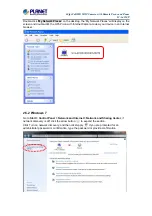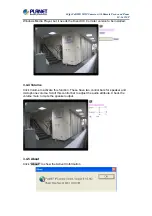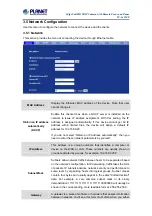
60fps Full HD IR IP Camera with Remote Focus and Zoom
ICA-4210P
IPv6
To enable or disable the IPv6 function here.
3.5.3 HTTPS
HTTPS: Stands for Hypertext Transfer Protocol Secure
HTTPS is a combination of the Hypertext Transfer Protocol with the SSL/TLS protocol to
provide encrypted communication and secure identification of a network web server. HTTPS
connections are often used for sensitive transactions in corporate information systems. The
main idea of HTTPS is to create a secure channel over an insecure network. This ensures
reasonable protection from eavesdroppers and man-in-the-middle attacks, provided that
adequate cipher suites are used and that the server certificate is verified and trusted.
HTTPS
To enable or disable the HTTPS service here. Note that the HTTPS
function of this device is not only encrypted the web content but also
audio/video data.
Port
Choose the HTTPS port. The default value is 443.
3.5.4 DDNS server
Stands for Dynamic Domain Name Server
The device supports DDNS If your device is connected to xDSL directly. You might need this
feature. However, if your device is behind a NAT router, you will not need to enable this feature.
Because DDNS allows the device to use an easier way to remember naming format rather
than an IP address. The name of the domain is like the name of a person, and the IP address
is like his phone number. On the Internet we have IP numbers for each host (computer, server,
router, and so on), and we replace these IP numbers to easily remember names, which are
organized into the domain name. As to xDSL environment, most of the users will use dynamic
IP addresses. If users want to set up a web or a FTP server, then the Dynamic Domain Name
Server is necessary. For more DDNS configuration, please consult your dealer.
Your Internet Service Provider (ISP) provides with you at least one IP address which is used to
connect to the Internet. The address you get may be static, meaning it never changes, or
dynamic, meaning it’s likely to change periodically. Just how often it changes, depending on
your ISP. A dynamic IP address complicates remote access since you may not know what
your current WAN IP address is when you want to access your network over the Internet. The
solution to the dynamic IP address problem comes in the form of a dynamic DNS service.
The Internet uses DNS servers to lookup domain names and translates them into IP
addresses. Domain names are just easy to remember aliases for IP addresses. A dynamic
DNS service is unique because it provides a means of updating your IP address so that your
listing will remain current when your IP address changes. There are several excellent DDNS
services available on the Internet and best of all they’re free to use. One such service you can
use is www.DynDNS.org. You’ll need to register with the service and set up the domain name
of your choice to begin using it. Please refer to the home page of the service for detailed
instructions or refer to Appendix E for more information.
















































